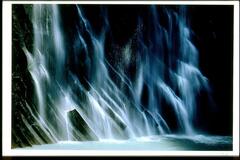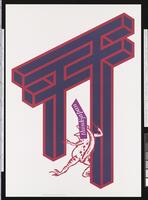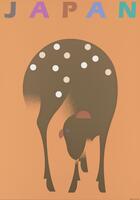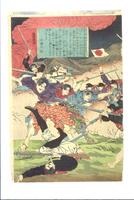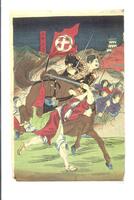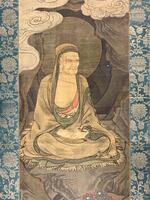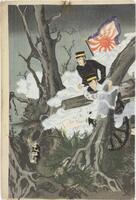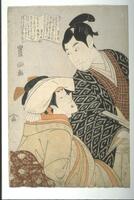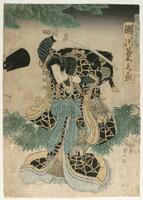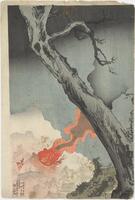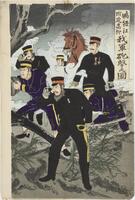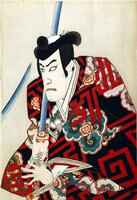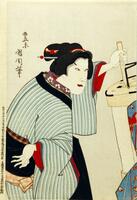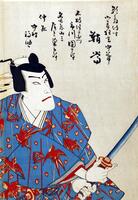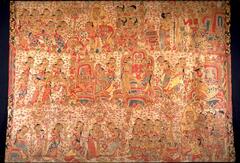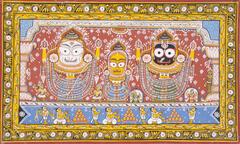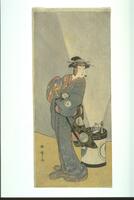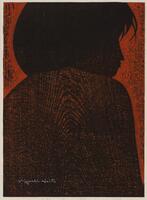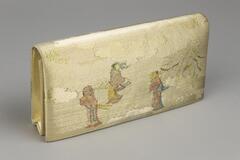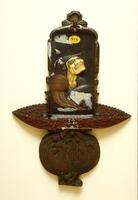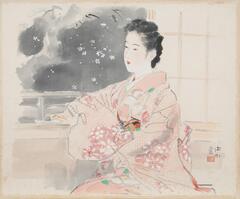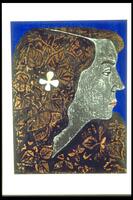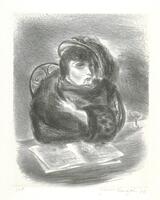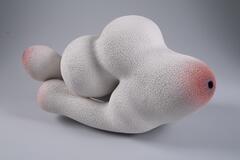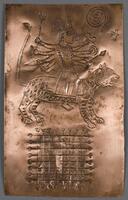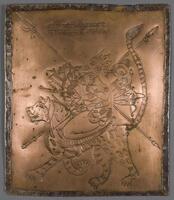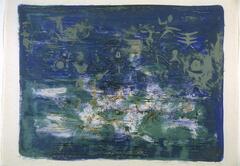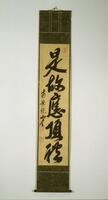37 Items in this Learning Collection
Collection Object
Collection Object
Collection Object
Collection Object
Collection Object
Collection Object
Collection Object
Collection Object
Collection Object
Collection Object
Collection Object
Collection Object
Collection Object
Collection Object
Collection Object
Collection Object
Collection Object
Collection Object
Collection Object
Collection Object
Collection Object
Collection Object
Collection Object
Collection Object
Collection Object
Collection Object
Copyright
All Rights Reserved
()
Arhat with Reliquary, (one of a pair)
Accession Number
2019/2.82
Title
Arhat with Reliquary, (one of a pair)
Artist(s)
Japanese
Artist Nationality
Japanese (culture or style)
Object Creation Date
15th century - 16th century
Medium & Support
hanging scroll, ink and color on silk
Dimensions
24 x 2 3/8 x 1 7/8 in. (60.96 x 6.03 x 4.76 cm);6 ft. 2 13/16 in. x 24 1/8 in. (190 x 61.2 cm);6 ft. 1 7/8 in. x 21 11/16 in. (187.5 x 55 cm)
Credit Line
Gift of the Hays Family - Frances Blakiston, James Griffith IV, Edward Lukens, and Charles Campbell - in memory of their grandmother, Mary Campbell Hays
Label copy
Copies and Invention in East Asia (August 17, 2019 - January 5, 2020)
Veneration of arhats—immortal disciples of the Buddha who have attained enlightenment and help spread Buddhist teachings—began in China, but spread throughout East Asia, becoming particularly linked with Chan/Zen Buddhism. Images of arhats are often found in temples, where an entire hall might be devoted to displaying multitudes of arhats. The two paintings on view here are likely from a temple.
Winter 2015 Gallery Rotation
In the Buddhist tradition, arhats are beings who have attained nirvana in life and will achieve final liberation, or release from the cycle of rebirth, at death. The historical Buddha is said to have selected certain arhats, traditionally numbering sixteen, to remain in the world after his death and disseminate his teachings until the arrival Maitreya, the Buddha of the future. These arhats are objects of devotion in the East Asian tradition and are almost always worshipped as a group rather than individually. In Japan, worship of the arhats began around the twelfth century.
In paintings, arhats are traditionally depicted as monks with shaved heads and loose robes, as they are here. The ring of light surrounding the head signifies an elevated status and the attainment of enlightenment. The arhat holding a small structure is likely Subinda, the last arhat to come to the Buddha. He is said to carry a pagoda, a structure used in early Buddhism to house the ashes of the historical Buddha; this would have served as a reminder of the Buddha and his teachings. The seated monk holds his hands in a gesture of concentration as he meditates; birds are beginning to flock to him, possibly drawn by his enlightened spirit. In Buddhism, animals are believed capable of attaining enlightenment, so it is possible that by accompanying a meditating arhat, the birds can further their own path to enlightenment. The figure with long white eyebrows and a head covering is likely the arhat Ajita. Subinda and Ajita are two of the sixteen great arhats.
Subject matter
In paintings, arhats are traditionally depicted as monks with shaved heads and loose robes, as they are here. The ring of light surrounding the head signifies an elevated status and the attainment of enlightenment. The arhat holding a small structure is likely Subinda, the last arhat to come to the Buddha. He is said to carry a pagoda, a structure used in early Buddhism to house the ashes of the historical Buddha; this would have served as a reminder of the Buddha and his teachings.
Physical Description
Long hanging scroll with printed gold and blue cloth on either side of the image. Image depicts an aged man sitting on a rock holding a relic in his right hand. A halo sits around his head. Above and behind him are waves and more rocks, suggesting he is seated on a rocky outcropping near a mass of water. The colors are heavily faded, though the robe around the man is primarily gold, with green and red accenting.
Primary Object Classification
Painting
Primary Object Type
hanging scroll
Additional Object Classification(s)
Painting
Collection Area
Asian
Rights
If you are interested in using an image for a publication, please visit http://umma.umich.edu/request-image for more information and to fill out the online Image Rights and Reproductions Request Form. Keywords
Buddhism
Figures
Japan
2019/2.82
Title
Arhat with Reliquary, (one of a pair)
Artist(s)
Japanese
Artist Nationality
Japanese (culture or style)
Object Creation Date
15th century - 16th century
Medium & Support
hanging scroll, ink and color on silk
Dimensions
24 x 2 3/8 x 1 7/8 in. (60.96 x 6.03 x 4.76 cm);6 ft. 2 13/16 in. x 24 1/8 in. (190 x 61.2 cm);6 ft. 1 7/8 in. x 21 11/16 in. (187.5 x 55 cm)
Credit Line
Gift of the Hays Family - Frances Blakiston, James Griffith IV, Edward Lukens, and Charles Campbell - in memory of their grandmother, Mary Campbell Hays
Label copy
Copies and Invention in East Asia (August 17, 2019 - January 5, 2020)
Veneration of arhats—immortal disciples of the Buddha who have attained enlightenment and help spread Buddhist teachings—began in China, but spread throughout East Asia, becoming particularly linked with Chan/Zen Buddhism. Images of arhats are often found in temples, where an entire hall might be devoted to displaying multitudes of arhats. The two paintings on view here are likely from a temple.
Winter 2015 Gallery Rotation
In the Buddhist tradition, arhats are beings who have attained nirvana in life and will achieve final liberation, or release from the cycle of rebirth, at death. The historical Buddha is said to have selected certain arhats, traditionally numbering sixteen, to remain in the world after his death and disseminate his teachings until the arrival Maitreya, the Buddha of the future. These arhats are objects of devotion in the East Asian tradition and are almost always worshipped as a group rather than individually. In Japan, worship of the arhats began around the twelfth century.
In paintings, arhats are traditionally depicted as monks with shaved heads and loose robes, as they are here. The ring of light surrounding the head signifies an elevated status and the attainment of enlightenment. The arhat holding a small structure is likely Subinda, the last arhat to come to the Buddha. He is said to carry a pagoda, a structure used in early Buddhism to house the ashes of the historical Buddha; this would have served as a reminder of the Buddha and his teachings. The seated monk holds his hands in a gesture of concentration as he meditates; birds are beginning to flock to him, possibly drawn by his enlightened spirit. In Buddhism, animals are believed capable of attaining enlightenment, so it is possible that by accompanying a meditating arhat, the birds can further their own path to enlightenment. The figure with long white eyebrows and a head covering is likely the arhat Ajita. Subinda and Ajita are two of the sixteen great arhats.
Subject matter
In paintings, arhats are traditionally depicted as monks with shaved heads and loose robes, as they are here. The ring of light surrounding the head signifies an elevated status and the attainment of enlightenment. The arhat holding a small structure is likely Subinda, the last arhat to come to the Buddha. He is said to carry a pagoda, a structure used in early Buddhism to house the ashes of the historical Buddha; this would have served as a reminder of the Buddha and his teachings.
Physical Description
Long hanging scroll with printed gold and blue cloth on either side of the image. Image depicts an aged man sitting on a rock holding a relic in his right hand. A halo sits around his head. Above and behind him are waves and more rocks, suggesting he is seated on a rocky outcropping near a mass of water. The colors are heavily faded, though the robe around the man is primarily gold, with green and red accenting.
Primary Object Classification
Painting
Primary Object Type
hanging scroll
Additional Object Classification(s)
Painting
Collection Area
Asian
Rights
If you are interested in using an image for a publication, please visit http://umma.umich.edu/request-image for more information and to fill out the online Image Rights and Reproductions Request Form. Keywords
Buddhism
Figures
Japan
